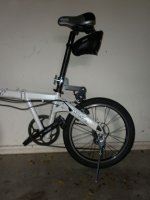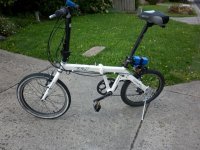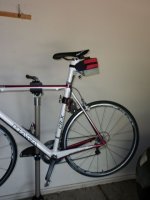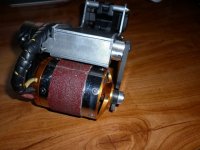Kepler
10 MW
I am sure a few people are getting sick of friction drives but love them or hate them, they are here to stay.
Adrian's Commuter Boost has been the focal point for quite some time now and as the active thread, I have been hopefully contributing to the forum via this discussion. However, with Adrian now looking at seriously selling some kits, I felt it was more appropriate for me to start up my own thread again rather then possibly stepping on toes.
To be clear, this is not about me trying to sell my own kits via the forum at this point. My drive is currently not available for sale and wont be for a few months yet. The purpose of this post is to just show the direction I am taking and where my development is currently up to.
For those who may be interested, I ended up manufacturing 40 of the original kits. These sold quite quickly and was an invaluable exercise in teaching just exactly what was involved in being a manufacturer. Financially, the exercise did me no favours. I think I broke even or maybe a little in front so no complains but certainly no windfall either.
The exercise taught me how important it was to optimize the design and to reduce both parts count and manufacturing cost. The original drive was costing me are around $250 to manufacture not including any of my time. Basically as it stood, it simply just wasn't economically viable. However, the concept and general design were sound and as such I felt it was well worth perusing.
Getting the opportunity to apear on the New Inventors television show was a fantastic experience. Winning the peoples choice award was a great honor and really lit a fire in my belly giving me the desire to take this to the next level. There is nothing like the exposure this sort of show gives you. I still get around 5 emails a day from the general public with enquires on where to purchase the drive.
Most forum members understand the short falls of RC based systems and know what is required to ride around them. Unfortunately Joe Public doesn't. Subsequently much of my focus has been in making the drive idiot proof. The Mythical Kepler interface is the key to success with the general public and has been where most of my time, money and effort has been spent. I have a fantastic association with a US based software engineer who has put in countless hours in development time on this unit. Unfortunately however, we are all doing this part time so progress been slower then we all would have liked.
Interestingly, it has been much more difficult to make the drive low powered then high powered especially on 6S configurations. The silly Australian limit of 200W is particularly difficult to deal with however we have got this under control now providing smooth reliable control. Our software has 3 programable power settings. 200W, 750W, and 1200W. Other programable items are max speed, wheel diameter, km or mph, battery type, and battery voltage. It also interfaces to LCD screen that can display anything we decide on.
The throttle is a push button arrangement only as apposed to a twist or thumb throttle. A minimum start speed is programmed into the unit. This is set at about walking pace. The drive is designed to speed match so whenever assistance is required, pushing the throttle button will give just enough throttle to hold speed if the bike was on flat ground. Pushing the button in quick succession increases speed. releasing the button for more the 1/2 a second switches the drive off. Progressive electronic ramps have also been utilised to ensure smooth engagement and disengagement.
A key speed controller protection feature is that output power is mapped against wheel speed. Lower speeds have lower Watt settings and as such puts much lower stresses on the ESC under these critical loads.
So now to the drive itself.
The design has gone through a number phases in a effort to reduce manufacturing costs and to improve the overall design. One of the major issues has been trying to make the drive fit as many bikes as possible. Other issues are the packaging of the electronics and battery configurations. I soon came to the realisation that the drive was never going to fit all bikes. However, I wanted to stay true to the original concept as much as I could especially keeping the quick release feature.
Enter the Mk 3 eboost Power Assist
This drive is designed around a modular set of parts whereby the major components are all common. However, a simple and cheap side frame replacement changes the configuration completely. The side frame replacement changes the drive from rear mount to centre mount and as such opens up a much wider range of bikes the drive can be fitted to.
In addition to this, the rear mount can be use as a platform to carry up to a single 5800mah 6S pack. In this configuration, the entire drive system can be removed from the bike in seconds.
So thats where I am up to at this stage. Getting some interfaces out there is the next big push.
Adrian's Commuter Boost has been the focal point for quite some time now and as the active thread, I have been hopefully contributing to the forum via this discussion. However, with Adrian now looking at seriously selling some kits, I felt it was more appropriate for me to start up my own thread again rather then possibly stepping on toes.
To be clear, this is not about me trying to sell my own kits via the forum at this point. My drive is currently not available for sale and wont be for a few months yet. The purpose of this post is to just show the direction I am taking and where my development is currently up to.
For those who may be interested, I ended up manufacturing 40 of the original kits. These sold quite quickly and was an invaluable exercise in teaching just exactly what was involved in being a manufacturer. Financially, the exercise did me no favours. I think I broke even or maybe a little in front so no complains but certainly no windfall either.
The exercise taught me how important it was to optimize the design and to reduce both parts count and manufacturing cost. The original drive was costing me are around $250 to manufacture not including any of my time. Basically as it stood, it simply just wasn't economically viable. However, the concept and general design were sound and as such I felt it was well worth perusing.
Getting the opportunity to apear on the New Inventors television show was a fantastic experience. Winning the peoples choice award was a great honor and really lit a fire in my belly giving me the desire to take this to the next level. There is nothing like the exposure this sort of show gives you. I still get around 5 emails a day from the general public with enquires on where to purchase the drive.
Most forum members understand the short falls of RC based systems and know what is required to ride around them. Unfortunately Joe Public doesn't. Subsequently much of my focus has been in making the drive idiot proof. The Mythical Kepler interface is the key to success with the general public and has been where most of my time, money and effort has been spent. I have a fantastic association with a US based software engineer who has put in countless hours in development time on this unit. Unfortunately however, we are all doing this part time so progress been slower then we all would have liked.
Interestingly, it has been much more difficult to make the drive low powered then high powered especially on 6S configurations. The silly Australian limit of 200W is particularly difficult to deal with however we have got this under control now providing smooth reliable control. Our software has 3 programable power settings. 200W, 750W, and 1200W. Other programable items are max speed, wheel diameter, km or mph, battery type, and battery voltage. It also interfaces to LCD screen that can display anything we decide on.
The throttle is a push button arrangement only as apposed to a twist or thumb throttle. A minimum start speed is programmed into the unit. This is set at about walking pace. The drive is designed to speed match so whenever assistance is required, pushing the throttle button will give just enough throttle to hold speed if the bike was on flat ground. Pushing the button in quick succession increases speed. releasing the button for more the 1/2 a second switches the drive off. Progressive electronic ramps have also been utilised to ensure smooth engagement and disengagement.
A key speed controller protection feature is that output power is mapped against wheel speed. Lower speeds have lower Watt settings and as such puts much lower stresses on the ESC under these critical loads.
So now to the drive itself.
The design has gone through a number phases in a effort to reduce manufacturing costs and to improve the overall design. One of the major issues has been trying to make the drive fit as many bikes as possible. Other issues are the packaging of the electronics and battery configurations. I soon came to the realisation that the drive was never going to fit all bikes. However, I wanted to stay true to the original concept as much as I could especially keeping the quick release feature.
Enter the Mk 3 eboost Power Assist
This drive is designed around a modular set of parts whereby the major components are all common. However, a simple and cheap side frame replacement changes the configuration completely. The side frame replacement changes the drive from rear mount to centre mount and as such opens up a much wider range of bikes the drive can be fitted to.
In addition to this, the rear mount can be use as a platform to carry up to a single 5800mah 6S pack. In this configuration, the entire drive system can be removed from the bike in seconds.
So thats where I am up to at this stage. Getting some interfaces out there is the next big push.








